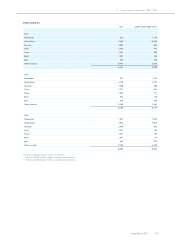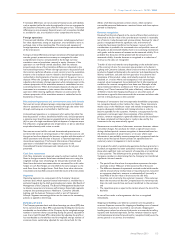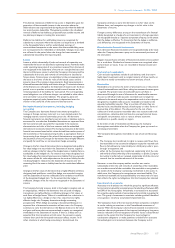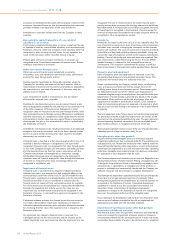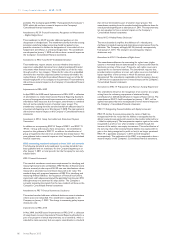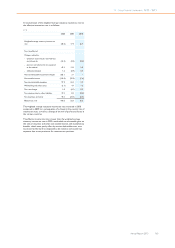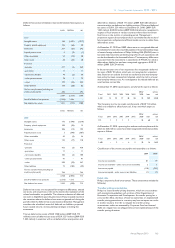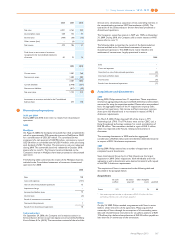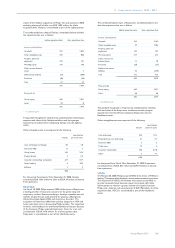Philips 2010 Annual Report Download - page 160
Download and view the complete annual report
Please find page 160 of the 2010 Philips annual report below. You can navigate through the pages in the report by either clicking on the pages listed below, or by using the keyword search tool below to find specific information within the annual report.
13 Group financial statements 13.10 - 13.10
160 Annual Report 2010
probable. The Company applied IFRIC 17 prospectively from January 1,
2010, which did not have a material impact on the Company’s
Consolidated financial statements.
Amendment to IAS 39 ‘Financial Instruments: Recognition and Measurement
– Eligible Hedged Items’
The amendment to IAS 39 provides additional guidance on the
designation of a hedged item. The amendment clarifies how the existing
principles underlying hedge accounting should be applied in two
particular situations. It clarifies the designation of a one-sided risk in a
hedged item and inflation in a financial hedged item. This amendment
was adopted on January 1, 2010 and did not have a material impact on
the Company’s Consolidated financial statements.
Amendments to IFRIC 9 and IAS 39 ‘Embedded Derivatives’
The amendments require entities to assess whether they need to
separate an embedded derivative from a hybrid (combined) financial
instrument when financial assets are reclassified out of the fair value
through profit or loss category. When the fair value of an embedded
derivative that would be separated cannot be measured reliably, the
reclassification of the hybrid (combined) financial asset out of the fair
value through profit or loss category is not permitted. The amendments
did not have a material impact on the Company’s Consolidated financial
statements.
Improvements to IFRSs 2009
In April 2009, the IASB issued ‘Improvements to IFRSs 2009‘, a collection
of amendments to twelve International Financial Reporting Standards,
as part of its program of annual improvements to its standards, which is
intended to make necessary, but non-urgent, amendments to standards
that will not be included as part of another major project. The
amendments resulting from this standard mainly have effective dates for
annual periods beginning on or after January 1, 2010. The improvements
did not have a material impact on the Company’s Consolidated financial
statements.
Amendment to IFRS 2 ‘Group Cash-settled and Share-based Payment
Transactions’
In addition to incorporating IFRIC 8, ‘Scope of IFRS 2’, and IFRIC 11,
‘IFRS 2 – Group and treasury share transactions’, the amendments
expand on the guidance in IFRIC 11 to address the classification of
group arrangements that were not covered by that interpretation. The
new guidance had no material impact on the Company’s Consolidated
financial statements.
IFRS accounting standards adopted as from 2011 and onwards
The following standards and amendments to existing standards have
been published and are mandatory for the Company beginning on or
after January 1, 2011 or later periods, but the Company has not early
adopted them:
IFRS 9 ‘Financial Instruments’
This standard introduces certain new requirements for classifying and
measuring financial assets and liabilities. IFRS 9 divides all financial assets
that are currently in the scope of IAS 39 into two classifications, those
measured at amortized cost and those measured at fair value. The
standard along with proposed expansion of IFRS 9 for classifying and
measuring financial liabilities, de-recognition of financial instruments,
impairment, and hedge accounting will be applicable from the year 2013,
although entities are permitted to adopt earlier. The Company is
currently evaluating the impact that this new standard will have on the
Company’s Consolidated financial statements.
Amendments to IFRS 7 Financial Instruments: Disclosures
The revised standard addresses additional disclosure notes in situations
where assets are reclassified. This amendment is applicable to the
Company on January 1, 2012. The change in accounting policy impacts
disclosures only.
Improvements to IFRSs 2010
In May 2010, the IASB issued ‘Improvements to IFRSs 2010‘, a collection
of amendments to seven International Financial Reporting Standards, as
part of its program of annual improvements to its standards, which is
intended to make necessary, but non-urgent, amendments to standards
that will not be included as part of another major project. The
amendments resulting from this standard mainly have effective dates for
annual periods beginning on or after January 1, 2011. The improvements
are not expected to have a material impact on the Company’s
Consolidated financial statements.
Revised IAS 24 ‘Related Parties Disclosures’
The revised standard simplifies the definition of a related party,
clarifying its intended meaning and eliminating inconsistencies from the
definition. The Company will apply IAS 24 (revised) retrospectively
from January 1, 2011. The change in accounting policy impacts
disclosures only.
Amendment to IAS 32 ‘Classification of Rights Issues’
The amendment addresses the accounting for rights issues (rights,
options or warrants) that are denominated in a currency other than the
functional currency of the issuer. Previously, such rights issues were
accounted for as derivative liabilities. The amendment requires that,
provided certain conditions are met, such rights issues are classified as
equity regardless of the currency in which the exercise price is
denominated. This amendment is applicable to the Company on January
1, 2011 and is not expected to have a material impact on the Company’s
Consolidated financial statements.
Amendment to IFRIC 14 ‘Prepayments of a Minimum Funding Requirement’
This amendment allows for the recognition of an asset for any surplus
arising from the voluntary prepayment of minimum funding
contributions for defined-benefit plans in respect of future service. The
amendment to IFRIC 14 will be adopted on January 1, 2011, will be
applied retrospectively and is not expected to have a material impact on
the Company’s Consolidated financial statements.
IFRIC 19 ‘Extinguishing Financial Liabilities with Equity Instruments’
IFRIC 19 clarifies the accounting when the terms of debt are
renegotiated with the result that the liability is extinguished by the
debtor issuing its own equity instruments to the creditor (referred to as
a ‘debt for equity swap’). The interpretation requires a gain or loss to be
recognized in profit or loss when a liability is settled through the
issuance of the entity’s own equity instruments. The reclassification of
the carrying value of the existing financial liability into equity (with no
gain or loss being recognized in profit or loss) is no longer permitted.
IFRIC 19 is applicable on January 1, 2011 and will be applied
retrospectively. The application of this IFRIC is not expected to have a
material impact on the Company’s Consolidated financial statements.





